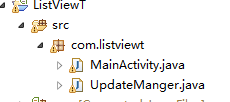編輯:Android資訊
Android單線程模型是這樣描述的:
Android UI操作並不是線程安全的,並且這些操作必須在UI線程執行
如果在其它線程訪問UI線程,Android提供了以下的方式:
Activity.runOnUiThread(Runnable) View.post(Runnable) View.postDelayed(Runnable, long) Handler
為什麼呢?在子線程中就不能操作UI麼?
當一個程序第一次啟動的時候,Android會同時啟動一個對應的主線程,這個主線程就是UI線程,也就是ActivityThread。UI線程主要負責處理與UI相關的事件,如用戶的按鍵點擊、用戶觸摸屏幕以及屏幕繪圖等。系統不會為每個組件單獨創建一個線程,在同一個進程裡的UI組件都會在UI線程裡實例化,系統對每一個組件的調用都從UI線程分發出去。所以,響應系統回調的方法永遠都是在UI線程裡運行,如響應用戶動作的onKeyDown()的回調。
那為什麼選擇一個主線程干這些活呢?換個說法,Android為什麼使用單線程模型,它有什麼好處?
先讓我們看下單線程化的事件隊列模型是怎麼定義的:
采用一個專門的線程從隊列中抽取事件,並把他們轉發給應用程序定義的事件處理器
這看起來就是Android的消息隊列、Looper和Handler嘛。類似知識請參考: 深入理解Message, MessageQueue, Handler和Looper
其實現代GUI框架就是使用了類似這樣的模型:模型創建一個專門的線程,事件派發線程來處理GUI事件。單線程化也不單單存在Android中,Qt、XWindows等都是單線程化。當然,也有人試圖用多線程的GUI,最終由於競爭條件和死鎖導致的穩定性問題等,又回到單線程化的事件隊列模型老路上來。單線程化的GUI框架通過限制來達到現場安全:所有GUI中的對象,包括可視組件和數據模型,都只能被事件線程訪問。
這就解釋了Android為什麼使用單線程模型。
那Android的UI操作並不是線程安全的又是怎麼回事?
Android實現View更新有兩組方法,分別是invalidate和postInvalidate。前者在UI線程中使用,後者在非UI線程中使用。換句話說,Android的UI操作不是線程安全可以表述為invalidate在子線程中調用會導致線程不安全。作一個假設,現在我用invalidate在子線程中刷新界面,同時UI線程也在用invalidate刷新界面,這樣會不會導致界面的刷新不能同步?既然刷新不同步,那麼invalidate就不能在子線程中使用。這就是invalidate不能在子線程中使用的原因。
postInvalidate可以在子線程中使用,它是怎麼做到的?
看看源碼是怎麼實現的:
public void postInvalidate() {
postInvalidateDelayed(0);
}
public void postInvalidateDelayed(long delayMilliseconds) {
// We try only with the AttachInfo because there's no point in invalidating
// if we are not attached to our window
if (mAttachInfo != null) {
Message msg = Message.obtain();
msg.what = AttachInfo.INVALIDATE_MSG;
msg.obj = this;
mAttachInfo.mHandler.sendMessageDelayed(msg, delayMilliseconds);
}
}
說到底還是通過Handler的sendMessageDelayed啊,還是逃不過消息隊列,最終還是交給UI線程處理。所以View的更新只能由UI線程處理。
如果我非要在子線程中更新UI,那會出現什麼情況呢?
android.view.ViewRoot$CalledFromWrongThreadException: Only the original thread that created a view hierarchy can touch its views.
拋了一個CalledFromWrongThreadException異常。
相信很多人遇到這個異常後,就會通過前面的四種方式中的其中一種解決:
Activity.runOnUiThread(Runnable) View.post(Runnable) View.postDelayed(Runnable, long) Handler
說到底還沒觸發到根本,為什麼會出現這個異常呢?這個異常在哪裡拋出來的呢?
void checkThread() {
if (mThread != Thread.currentThread()) {
throw new CalledFromWrongThreadException(
"Only the original thread that created a view hierarchy can touch its views.");
}
}
該代碼出自 framework/base/core/java/android/view/ViewRootImpl.java
再看下ViewRootImpl的構造函數,mThread就是在這初始化的:
public ViewRootImpl(Context context, Display display) {
mContext = context;
mWindowSession = WindowManagerGlobal.getWindowSession();
mDisplay = display;
mBasePackageName = context.getBasePackageName();
mDisplayAdjustments = display.getDisplayAdjustments();
mThread = Thread.currentThread();
......
}
再研究一下這個CalledFromWrongThreadException異常的堆棧,會發現最後到了invalidateChild和invalidateChildInParent方法中:
@Override
public void invalidateChild(View child, Rect dirty) {
invalidateChildInParent(null, dirty);
}
@Override
public ViewParent invalidateChildInParent(int[] location, Rect dirty) {
checkThread();
......
}
最終通過checkThread形成了這個異常。說到底,非UI線程是可以刷新UI的呀,前提是它要擁有自己的ViewRoot。如果想直接創建ViewRoot實例,你會發現找不到這個類。那怎麼做呢?通過WindowManager。
class NonUiThread extends Thread{
@Override
public void run() {
Looper.prepare();
TextView tx = new TextView(MainActivity.this);
tx.setText("non-UiThread update textview");
WindowManager windowManager = MainActivity.this.getWindowManager();
WindowManager.LayoutParams params = new WindowManager.LayoutParams(
200, 200, 200, 200, WindowManager.LayoutParams.FIRST_SUB_WINDOW,
WindowManager.LayoutParams.TYPE_TOAST,PixelFormat.OPAQUE);
windowManager.addView(tx, params);
Looper.loop();
}
}
就是通過windowManager.addView創建了ViewRoot,WindowManagerImpl.java中的addView方法:
@Override
public void addView(@NonNull View view, @NonNull ViewGroup.LayoutParams params) {
applyDefaultToken(params);
mGlobal.addView(view, params, mDisplay, mParentWindow);
}
private final WindowManagerGlobal mGlobal = WindowManagerGlobal.getInstance();
mGlobal是一個WindowManagerGlobal實例,代碼在 frameworks/base/core/java/android/view/WindowManagerGlobal.java中,具體實現如下:
public void addView(View view, ViewGroup.LayoutParams params,
Display display, Window parentWindow) {
if (view == null) {
throw new IllegalArgumentException("view must not be null");
}
if (display == null) {
throw new IllegalArgumentException("display must not be null");
}
if (!(params instanceof WindowManager.LayoutParams)) {
throw new IllegalArgumentException("Params must be WindowManager.LayoutParams");
}
final WindowManager.LayoutParams wparams = (WindowManager.LayoutParams) params;
if (parentWindow != null) {
parentWindow.adjustLayoutParamsForSubWindow(wparams);
} else {
// If there's no parent, then hardware acceleration for this view is
// set from the application's hardware acceleration setting.
final Context context = view.getContext();
if (context != null
&& (context.getApplicationInfo().flags
& ApplicationInfo.FLAG_HARDWARE_ACCELERATED) != 0) {
wparams.flags |= WindowManager.LayoutParams.FLAG_HARDWARE_ACCELERATED;
}
}
ViewRootImpl root;
View panelParentView = null;
synchronized (mLock) {
// Start watching for system property changes.
if (mSystemPropertyUpdater == null) {
mSystemPropertyUpdater = new Runnable() {
@Override public void run() {
synchronized (mLock) {
for (int i = mRoots.size() - 1; i >= 0; --i) {
mRoots.get(i).loadSystemProperties();
}
}
}
};
SystemProperties.addChangeCallback(mSystemPropertyUpdater);
}
int index = findViewLocked(view, false);
if (index >= 0) {
if (mDyingViews.contains(view)) {
// Don't wait for MSG_DIE to make it's way through root's queue.
mRoots.get(index).doDie();
} else {
throw new IllegalStateException("View " + view
+ " has already been added to the window manager.");
}
// The previous removeView() had not completed executing. Now it has.
}
// If this is a panel window, then find the window it is being
// attached to for future reference.
if (wparams.type >= WindowManager.LayoutParams.FIRST_SUB_WINDOW &&
wparams.type <= WindowManager.LayoutParams.LAST_SUB_WINDOW) {
final int count = mViews.size();
for (int i = 0; i < count; i++) {
if (mRoots.get(i).mWindow.asBinder() == wparams.token) {
panelParentView = mViews.get(i);
}
}
}
root = new ViewRootImpl(view.getContext(), display);
view.setLayoutParams(wparams);
mViews.add(view);
mRoots.add(root);
mParams.add(wparams);
}
// do this last because it fires off messages to start doing things
try {
root.setView(view, wparams, panelParentView);
} catch (RuntimeException e) {
// BadTokenException or InvalidDisplayException, clean up.
synchronized (mLock) {
final int index = findViewLocked(view, false);
if (index >= 0) {
removeViewLocked(index, true);
}
}
throw e;
}
}
所以,非UI線程能更新UI,只要它有自己的ViewRoot。
延伸一下:Android Activity本身是在什麼時候創建ViewRoot的呢?
既然是單線程模型,就要先找到這個UI線程實現類ActivityThread,看裡面哪裡addView了。沒錯,是在onResume裡面,對應ActivityThread就是handleResumeActivity這個方法:
final void handleResumeActivity(IBinder token,
boolean clearHide, boolean isForward, boolean reallyResume) {
// If we are getting ready to gc after going to the background, well
// we are back active so skip it.
unscheduleGcIdler();
mSomeActivitiesChanged = true;
// TODO Push resumeArgs into the activity for consideration
ActivityClientRecord r = performResumeActivity(token, clearHide);
......
if (r.window == null && !a.mFinished && willBeVisible) {
r.window = r.activity.getWindow();
View decor = r.window.getDecorView();
decor.setVisibility(View.INVISIBLE);
ViewManager wm = a.getWindowManager();
WindowManager.LayoutParams l = r.window.getAttributes();
a.mDecor = decor;
l.type = WindowManager.LayoutParams.TYPE_BASE_APPLICATION;
l.softInputMode |= forwardBit;
if (a.mVisibleFromClient) {
a.mWindowAdded = true;
wm.addView(decor, l);
}
// If the window has already been added, but during resume
// we started another activity, then don't yet make the
// window visible.
} else if (!willBeVisible) {
if (localLOGV) Slog.v(
TAG, "Launch " + r + " mStartedActivity set");
r.hideForNow = true;
}
......
}
所以,如果在onCreate中通過子線程直接更新UI,並不會拋CalledFromWrongThreadException異常。但是一般情況下,我們不會在onCreate中做這樣的事情。
這就是Android為我們設計的單線程模型,核心就是一句話:Android UI操作並不是線程安全的,並且這些操作必須在UI線程執行。但這一句話背後,卻隱藏著我們平時看不見的代碼實現,只有搞懂這些,我們才能知其然知其所以然。
 Android推送技術研究
Android推送技術研究
前言 最近研究Android推送的實現, 研究了兩天一夜, 有了一點收獲, 寫下來既為了分享, 也為了吐槽. 需要說明的是有些東西偏底層硬件和通信行業, 我對這些
 Android 軟件自動更新功能實現的方法
Android 軟件自動更新功能實現的方法
本篇文章小編為大家介紹,Android 軟件自動更新功能實現的方法。需要的朋友參考下。 相信所有的用戶都遇到過軟件提醒更新的情況,下面就將實現此功能 首先看一下程
 Android 存儲系統之架構篇
Android 存儲系統之架構篇
基於Android 6.0的源碼,剖析存儲架構的設計 Android 存儲系統之源碼篇 Android 存儲系統之架構篇 一、概述 本文講述Android存儲系統
 如何反編譯Android 5.0 framework
如何反編譯Android 5.0 framework
在Android平台,對於和硬件交互相關的模塊來說,比如:和雙卡對應的Telephony模塊、和拍照對應的Camera模塊,以及Bluetooth模塊等等,不同廠